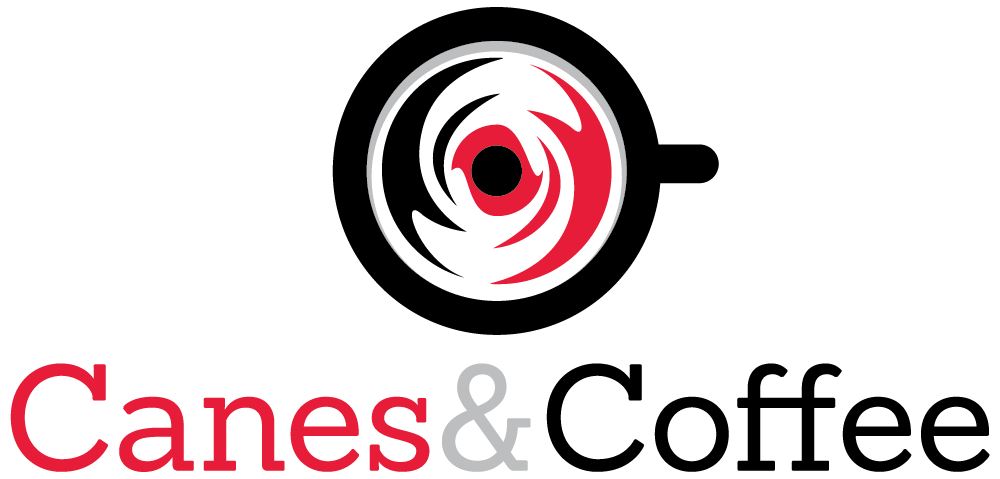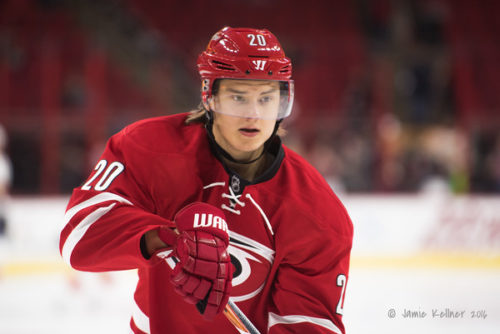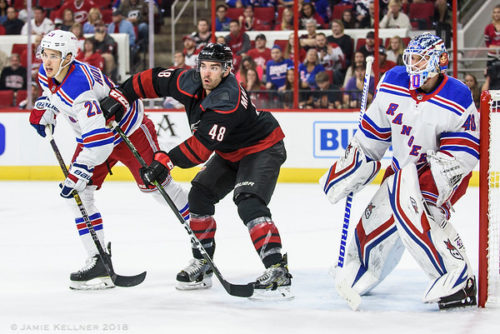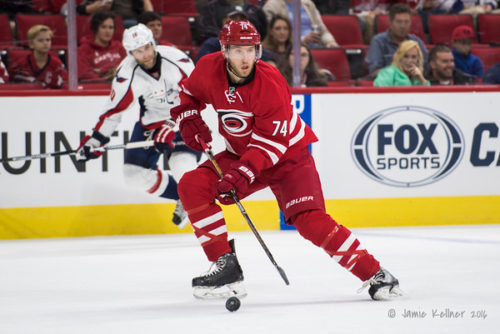With Hurricanes scheduled to collide with the Maple Leafs at PNC Arena on Sunday, timing is good to finally write an article that I have pondered before. I find the Hurricanes and Maple Leafs’ in-process rebuilds interesting both because of key striking similarities but also because of points where they diverge significantly. I also think it will be interesting to see how the two teams’ projects unfold over the next couple years.
A similar restart at the top
In the span of a little more than a month at the end of the 2013-14 NHL season, the Hurricanes saw long-time general manager Jim Rutherford step down and a new era begin with the announcement that Ron Francis would be the new general manager. From day one Francis’ mantra was loud, clear and repeated regularly. His plan was to build from within with the goal not just of returning to the playoffs again but equally importantly doing so in a way that was sustainable and made the Hurricanes a regular participant in the postseason.
The word “rebuilding” is generally synonymous with “not going to win in the upcoming season.” As such, it is rarely used by teams even if they are in fact rebuilding. But Francis’ words could not have been more clear that he was undertaking a rebuilding project when he took the helm on April 28, 2014. Despite some urgency to return to the playoffs after five consecutive misses since the 2009 playoffs, Francis made it clear that he was going to do it the right way.
Meanwhile about 700 miles north in Toronto a somewhat similar undertaking was beginning. The storied Toronto Maple Leafs made the playoffs in 2013 only to suffer a heartbreaking collapse and defeat at the hands of the enemy Bruins; otherwise the Leafs’ playoff drought was as bad as the Hurricanes’ dry spell stretching back to the start of the salary cap era for the NHL that took away much of the financial advantage previously possessed by large market teams. And this is where the parallels start. On April 11, 2014, Brendan Shanahan was hired by the Toronto Maple Leafs as president of the hockey club. And just like Francis, Brendan Shanahan immediately started talking about building from within and avoiding quick fixes.
The hockey markets could not be more night and day with Toronto as an Original Six team and arguably the center of the hockey universe and the Hurricanes a less than 20 years in a non-traditional southern US hockey market after a surprising move from Hartford. But within a mere 17 days of each other, both the Carolina Hurricanes and the Toronto Maple Leafs had started on similar journeys to start anew and rebuild their franchises. And though the official titles and roles for Ron Francis and Brendan Shanahan are different, both clubs that had sputtered through years of unsuccessful attempts to find quick fixes, finally put a stake in the ground and made a change at the very top of the organization with the aim of charting a new course. In adding Ron Francis and Brendan Shanahan, the Hurricanes and the Maple Leafs respectively reached for new leadership cut from the cloth of Hall-of-Fame careers with multiple Stanley Cup rings.
Building the management team
Francis’ first move in his new role only 17 days after being hired was to fire coach Kirk Muller. After some time for an interview process, Francis’ second move was to start anew behind the bench hiring Detroit Red Wings’ assistant Bill Peters. Peters came from a winning culture and arrived with a reputation for being a master of details.
And just like with the Hurricanes, Shanahan’s most significant early moves focused on revamping his management team. One year later on May 20, 2015, the Maple Leafs capitalized on the fact that the salary cap did not apply to coaches. Shanahan added the best coach money could buy when he lured Mike Babcock out of Detroit with a massive $50 million contract. Two months later on July 23, 2015, Shanahan added long-time Devils’ general manager Lou Lamoriello to his staff.
With the usual changeover in coaches when a new head coach is hired, the end result for both teams was a radical overhaul of the personnel who managed the teams both on and off the ice.
Early differences arise in the management ranks
The parallels noted above are striking and the matching timelines set the two teams up for benchmarking going forward. But the series of moves in the management ranks also marks the first striking difference between the two rebuilding programs. Whereas the Maple Leafs added a head coach with 786 games and 458 wins of NHL head coaching experience including a Stanley Cup and significant big stage international coaching experience, the Hurricanes were taking a shot on a brand new NHL bench boss. Peters’ experience in the same winning organization as Babcock as an assistant was nothing to frown at, but his experience holding the reins at the NHL level prior to the Hurricanes job was exactly 0 games.
In addition, Ron Francis had a reasonable run of 8 years first in a player development role then as an assistant general manager under experienced general manager Jim Rutherford. But like Peters, he was taking his first turn actually in charge of the controls. In contrast and at the other extreme of the spectrum, Brendan Shanahan rounded out his team by plucking Lou Lamoriello from New Jersey and adding 28 years of general management experience and 3 more Stanley Cups to his management team.
Ron Francis slowly and methodically transitions the roster
On the ice, the teams were in a similar position. Both teams were mostly bad at the NHL level but yet light on prospect quality and quantity from spending much of it for short-term fixes and were carrying some bad contracts to boot.
When Ron Francis took over, the Hurricanes had last made the playoffs in 2009. He inherited a team that finished 24th in the 2013-14 season. In addition, he inherited a team in a bad place financially with minimal short-term flexibility. The top heavy roster had salary commitments $35 million in just 5 players – Eric Staal at $9.25 million, Alexander Semin at $7 million, Cam Ward at $6.7 million, Jeff Skinner at $6 million and Jordan Staal at $6 million. Francis would expedite the salary reduction by biting the bullet and buying out Alexander Semin in June of 2015, and then patiently wait for the big contracts of Cam Ward and Eric Staal to come off the books the following summer, finally creating some financial flexibility.
With a steadfast commitment to his ‘build from within’ mantra, Francis’ approach to building his team was both consistent and simple. He steered clear of making trades for quick fixes. He made only minor additions via free agency. And more than anything he used the trade deadline to trade off any and all impending unrestricted free agents to add additional futures and expedite the rebuild process and replenish a depleted prospect pool.
The summer of 2014: In his first summer as general manager, Francis added only depth players Brad Malone, Jay McClement and Tim Gleason for a total of $2.9 million
The 2015 trade deadline: After unloading Jay Harrison in the fall for a sixth round pick, Francis moved Jiri Tlusty for a third and sixth round pick, Tim Gleason for a fourth round pick and Andrej Sekera for a first round pick and prospect Roland McKeown who was a recently second round pick. The total haul added nearly an entire draft, 6 picks and prospects, to the Hurricanes prospect pool.
The summer of 2015: Again, Francis would spend frugally to make only depth additions on the cheap. Almost simultaneously, Francis traded backup goalie Anton Khudobin to add a veteran top 4 defenseman in James Wisniewski and also traded a third and a seventh round pick to replace Khudobin with Eddie Lack from a trade with Vancouver. Then at the end of the summer, Francis capitalized on the Blackhawks’ salary cap situation and added depth forwards Kris Versteeg and Joakim Nordstrom in addition to collecting a third round draft pick for helping Chicago squeeze under the salary cap ceiling just before the start of training camp. Francis gave up only a fifth round pick, recent sixth round pick Jake Massie and an AHL defenseman.
The 2016 trade deadline: The 2016 trade deadline was a repeat of the 2015 trade deadline except that assets for sale the second time around were even more significant. Long-time captain Eric Staal was traded for two second round picks and recent third-rounder Aleksi Saarela. Kris Versteeg netted second-rounder Valentin Zykov. John-Michael Liles garnered a third and a fifth round pick. For the second consecutive trade deadline, Francis added a total of 6 prospects and picks with the majority from the top half of the draft.
The summer of 2016: Francis’ third summer as general manager started with a bang and another move that took advantage of the NHL’s salary cap rules. In his second deal with Chicago, Francis was able to get a proven young NHLer with upside in 22-year old Teuvo Teravainen without giving up a roster player. Instead, Francis paid modestly with only a second and a third round draft pick and more significantly by taking Bryan Bickell and his $4.5 million salary cap hit to help the Blackhawks make the math work for the second consecutive summer. After the Teuvo Teravainen splash, Francis again hunkered down, played things conservatively and spent modestly to fill a couple roster openings. He added two veteran forwards in Lee Stempniak and Viktor Stalberg for a total cost of $4 million in salary. Francis’ biggest decision of the summer was to in net. With Cam Ward coming off of his big $6.8 million per season long-term deal and a range of options available via free agency or trade during the summer, Francis passed on higher-end options and instead re-upped with Ward for 2 years at $3.3 million per season.
Then and now: Cory Fogg detailed the full transformation at a transaction level in his in-depth post at the end of January. When you look at the transition now over 2 1/2 seasons under Ron Francis, the NHL roster is significantly younger and costs significantly less than what Francis inherited. Also, below the NHL level, the team’s prospect pool is significantly improved in terms of volume from the draft picks added at the trade deadlines and is also stocked with more potential higher-end players.
Brendan Shanahan and Lou Lamoriello use a similar approach in Toronto
The summer of 2014: In some ways, the summer of 2014 was the last hurrah for the old way of doing business for the Maple Leafs. In that summer before the arrival of Lou Lamoriello, the Maple Leafs would sign Stephane Robidas for 3 years at $3 million per year and also Leo Komarov for 4 years at $2.95 per year. Toronto would also sign Daniel Winnik, Mike Santorelli and David Booth to inexpensive 1-year deals for reasons we will see below.
The 2015 trade deadline: Matching the approach of Ron Francis and the Hurricanes, the Maple Leafs would going on a trade deadline selling spree aimed at rebuilding the prospect pool with extra draft picks. Toronto would trade Cody Franson, Mike Santorelli, Daniel Winnik and Korbinian Holzer and net 4 draft picks plus a couple mid-tier prospects for their efforts.
The summer of 2015: Whereas the summer of 2014 was a fairly quiet summer in Toronto, the summer of 2015 saw the first of two significant deals that affected the veteran leadership on the team. After a full season to assess players and contemplate direction, Toronto traded Phil Kessel to Pittsburgh for a collection of futures.
The 2016 trade deadline: The second shoe dropped on February 9, 2016 when the Maple Leafs traded captain Dion Phaneuf to Ottawa for a collection of players and futures. Lamoriello would proceed to go full Francis at the trade deadline and do four more deals sending away veterans and receiving picks and prospects in return. When the dust settled, Toronto had added 5 draft picks and also a few prospects.
The summer of 2016: With the expected arrival of young rookies Auston Matthew and Mitch Marner, the Maple Leafs added rugged Matt Martin and Roman Polak to provide a physical element if needed. The team also went all in at the goalie position paying significantly in the form of a first and a second round pick to obtain Frederik Andersen from Anaheim and then paying significantly again in the form of a long-term contract for $5 million per year.
Then and now: The story of the Maple Leafs rebuild is similar to the Hurricanes in that both teams aggressively dealt away impending free agents at the trade deadlines to add extra draft picks and bolster their prospect pools. Both teams also leveraged the NHL’s salary cap rules though in somewhat different ways. The Hurricanes and Ron Francis preyed on the Blackhawks need to cut salary in two separate deals. The Maple Leafs and Brendan Shanahan also used the salary cap rules in their favor probably collecting extra assets in a couple deals by taking back a few contracts. For the 2016-17 season, the random salary cap commitments for the Maple Leafs are numerous. They have $1.2 million of retained salary, $1.3 million for a buy out, $8.2 million in buried contracts and $13.3 million in injured players who are unlikely to return to the NHL. That is a TON of money tied up in unproductive assets, but while the team was rebuilding it fit within the plan to add a few extra assets. $11.3 million will come off the books at the end of the 2016-17 season, and most of the rest of it is for players who can be put on long-term injured reserved to provide salary cap flexibility.
Key differences between the current state of the Maple Leafs and Hurricanes’ rebuilds
While deep similarities exist between the starting points in terms of revamping management and coaching, leveraging the NHL salary cap rules and above all else using youth as a foundation, there are some striking differences between the two rebuild programs and where the franchises are right now.
Immediate progress in the 2016-17 season
Declaring anything final for the 2016-17 season would be premature, but as of right now, the Maple Leafs are reasonably securely in a playoff spot while the Hurricanes need to jump in a hurry to avoid another berth in the lottery draft.
Converting high draft picks into nearly instant team leaders
If I had to pick one thing that jumped out as different and a key component of the Leafs temporarily vaulting ahead, it would be the results of the past few NHL drafts. Toronto is led by its top forwards and those top forwards are largely the result of the past three NHL drafts. Three of the NHL’s top four rookie scorers are young Leafs. William Nylander who was selected eighth overall in the 2014 draft has 38 points. Auston Matthews who was selected first overall in the 2016 NHL draft is third overall with 46 points and a huge 40-goal pace. And Mitch Marner who was selected fourth overall in the 2015 NHL draft is tied for first in rookie scoring with 48 points.
Whether it be attributed to bad luck, the wrong selections or very possibly just the need for patience, the Hurricanes first-round picks from those drafts have yet to make a real impact at the NHL level. Haydn Fleury who was selected one place before William Nylander is making progress in his development at the AHL level but has yet to play in an NHL game. Noah Hanifin who was selected on spot after Mitch Marner is playing at the NHL level but only in a ‘still learning’ third pairing role. And the Hurricanes two first-round picks in 2016, Jake Bean and Julien Gauthier are still developing at the juniors level. The Hurricanes have been fortunate to have lower draftees in Jaccob Slavin, Brett Pesce and Sebastian Aho rise up and assume significant roles at the NHL level, but the team has not yet managed anything even close to the same level of impact from its recent top draftees.
Defensemen versus forwards
Another thing that jumps out is the relative positional strength. As noted above, the Maple Leafs are led by a rapidly developing group of elite young forwards. Toronto does also have a couple young defensemen in the mix including Jake Gardiner and Morgan Rielly who are expected to be long-term mainstays, but the team’s strength is clearly at the forward position. By contrast, the Hurricanes strength is very clearly on the blue line. The team has three young defensemen in Jaccob Slavin, Brett Pesce and Justin Faulk filling key roles in the top 4 already, 20-year old Noah Hanifin developing at the NHL level and a deep prospect pool that includes Haydn Fleury, Roland McKeown and Jake Bean who all have top 4 potential. Interestingly, early rumblings leading up to the 2017 NHL trade deadline note the relative strengths with the Leafs allegedly looking to add a top blue-liner and possibly dangling William Nylander to do so, and the Hurricanes linked to forwards like Matt Duchene and Gabriel Landeskog and just maybe willing to spend from their blue line depth to do so.
The goalie position
In terms of pure ‘stake in the ground’ decision-making, the teams’ respective decisions at the goalie position are the most different. As noted above, last summer the Maple Leafs decided to get arguably the best money could buy at the goalie position when they traded a small ransom (first and second round draft picks) to add Frederik Anderson and then sign him for 5 years at $5 million per season. In so doing, Toronto’s management made a significant long-term commitment at the position. Meanwhile after at least initial consideration of the options available, Francis made a smaller move with a shorter commitment when he chose to re-sign Cam Ward to a modest 2-year deal at $3.3 million per year to kick the can down the road in a low risk manner.
The real evaluation point is still to come
As noted above, the Maple Leafs have the short-term edge for the 2016-17 season, but it is premature to make any final judgments. The real measuring point sits 2-3 year out after we have seen these teams make the playoffs (or not) and how they fare in trying to push deep into the playoffs and become legitimate Stanley Cup contenders.
Go Canes!




I mean, while I like what you do with this article, Toronto’s rebuild is the closest thing to legal cheating, compared to what Ron Francis has had to do. You’ve got a #1 overall (Matthews) when we’re drafting from the 13 spot, and then the #4 (Marner) ahead of our #5 (Hanifin) and our #35 (Aho) who could end up being just as good as Marner. Combine that with the PILES of money Toronto is using to lock up Mike Babcock, of all coaches, plus dropping 25 mil on an average starting goalie in Frederik Andersen, and they still have millions to spare.
We can’t rebuild Toronto-style, we have maybe 1/10 of their cash, and 1/100 the fanbase to help the NHL rig the draft lottery in our favor 😉 I know this wasn’t the point of the article, but I think it’s far more impressive that Ron has gotten to this point of his rebuild with a lot fewer resources than the Leafs. They might make the playoffs before us, they might not, but the fact that they bought their temporary lead in this race means nothing. The Hurricanes will be a force in the years to come, especially when Ron can add to that pool of prospect talent one more time, actually with a higher pick than the Leafs (though show of hands, who’d be shocked if Toronto still pulled off a miracle draft lottery win. I’ll pit Slavin and Pesce against Matthews any day, and let Aho and Marner battle it out, and we’ll see who’s done the better job with the rebuild. Stupid Toronto.
The point above is dead on: Toronto has deep pockets. Their cap number is roughly $14-mil more than ours this year. Imagine what the Canes might look like if we had 2 more $5-mil/yr offensive players (to make up the difference).
Fundamentally, the amount of financial resources ownership is willing to spend affects the team that skates every night. Canes ownership just doesn’t have the same wealth – or willingness to invest – that Toronto’s does. Obviously, the market matters, but the cap is the same for both teams. Toronto is just using more of it, even if a lot of it isn’t skating or on the active roster.
Our organizational depth has improved dramatically since RF took over. There are opportunistic moves to be made over the next two weeks and before the expansion draft. I believe we will continue to improve.
I just hope the fan base is rewarded before the financials fall apart on Peter Karmanos.
Long-term I agree that Toronto has a big edge financially being able to spend to the cap and use things like buy outs more liberally because the $ don’t matter.
But as of right now, I actually don’t agree. The Leafs salary #s are inflated by the fact that they took/kept some bad contracts (basically a larger dose of the Bickell move). If you back out their LTIR & buried contracts and similarly back out Bickell’s contract, the 2 teams ‘adjusted spending for actual players’ is nearly equal.
If you had to ask me the biggest difference at this point in time (which could change), it’s that Toronto yielded a couple elite players from their recent 1st round picks and thus far the Canes haven’t.
Sorry, I fail to see how RF is building the team the RIGHT WAY!
I call BS… That’s just code for …we gonna get a bunch of guys real cheap! A lot-a-Cheap don’t mean good… Charlotte s/b better, if that was how it worked…??
How many of our Ahl and juniors are CAN’T MISS? Who among the current roster is a STAR-IN-MAKING? Where in the organization is a decent goalie-prospect?
AND FINALLY, THAT MONEY THEY ALLEDGEDLY WERE SAVING FOR RETAINING OUR YOUNG STARS… who’s deserving of a significant raise?
The proof is in the pudding… and the stats tell the story!